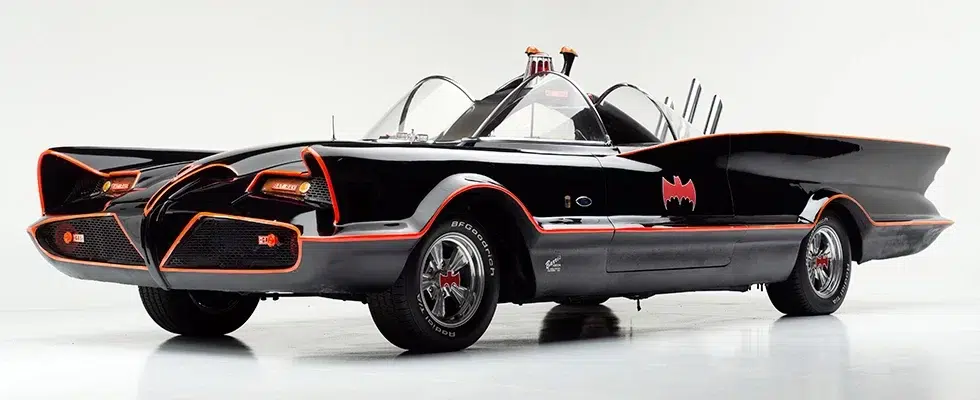The Full Story of the 1966 Batmobile & Burt Ward’s Near Death Experience
Holy classic car, Batman! Those cheesy lines. The pows, bams, and zonks that flash across the screen. The zany colored spandex costumes, and the Batusi. They’re all the essential ingredients of the campy Adam West Batman TV series that ran from 1966 to 1968.
But, like Batman, the show was nothing without the 1966 Batmobile.
The iconic vehicle was the first live-action Batmobile with its own Bat design and Bat gadgets. It captured the imaginations of young boys and their Dads. Even today, almost 60 years on, the 1966 Batmobile still draws crowds at car shows and replicas are made for wealthy collectors.
In this article, we’ll look at how the car was designed and customized from a Lincoln Futura concept car in record time to meet the production deadline. We’ll also look into its second life at car shows, how the car influenced other Batmobiles, and that time Burt Ward was almost thrown from the vehicle at high speed.
When Batman producer William Dozier first began preparations for the TV series, he recognized the need for a distinctive vehicle for the Caped Crusader to drive in 1960s America.
It needed to be a Bat-version of a classic American car. And a car that could rival James Bond’s tricked-out Aston Martin DB5, which made its debut two years earlier in Goldfinger.
So Dozier turned to Hollywood car customizer, Dean Jeffries, who drew up plans to alter a 1959 Cadillac Eldorado.
But Dozier’s three-week deadline proved too ambitious for Jeffries, and he gave the project to George Barris.
Barris, known as Hollywood’s “King of Kustoms”, made famous customized cars including the 1921 Oldsmobile for The Beverley Hillbillies, The Munster Koach for The Munsters, and KITT from Knight Rider.
But his Batmobile is the car he is most remembered for.
Lincoln Futura Concept Car
Barris used the Lincoln Futura concept car as the basis for the 1966 Batmobile. Ford’s top designers Bill Schmidt and John Naijar created the concept and the Italian Ghia design studio hand-built the car for the 1955 Chicago Auto Show.
Only one model was made. It was not the car of the future Ford hoped. But some of the Futura’s design features did make it into other Lincoln models. The Futura did have a brief second life as a movie prop, appearing in one film called It Started With A Kiss starring Debbie Reynolds.
In 1961, Ford used the Lincoln Futura for their promotional film, The Secret Door, showcasing their design studio. In the film, the Futura is consigned to Ford’s design history, which was quite ironic considering the car’s name. With no purpose, the car was sold that same year to George Barris for $1. Really, just one buck.
(That price was quite a comedown from the approximately $250,000 Ford spent on designing and building the concept car in the mid-1950s)
Building the 1966 Batmobile
When the Batman production team came knocking, Barris saw how the Lincoln Futura’s design could be altered to resemble the Batmobile. With a production artist from the TV show and five of Barris’s crew, the team got to work.
Twentieth Century Fox gave the crew a $15,000 budget for the transformation.
Some of the Futura’s features were already near perfect. The futuristic Plexiglas bubble canopy that fits over the occupants was a similar design to the “bubble dome” of the Batmobile that was featured in the comics from 1954 to 1957. The middle section was cut from the dome to turn it into a convertible. But the rest of the dome remained largely untouched.
The designs of the Batmobile in the comics and the Futura are both inspired by the features of an animal. The Futura’s tail fins, elevated bonnet, and widened bumper were inspired by the designer’s encounter with a mako shark. Thousands of tiny fish scales added to the pearlescent white paint job finished the effect.
To make the shark-like features of the Lincoln Futura more bat-like, Barris’s team scalloped the trailing edge of the tail fins into bat wings. The top, leading edge of the fins was also extended into the doors. And the car’s bumper was altered to become an integrated Bat-tering ram.
The final touch to the bodywork involved removing the white fish scales and painting it gloss black with a red trim that accentuated the car’s contours.
To finish off the look, the Futura’s steering wheel was exchanged with one from a 1958 Edsel.
Gadgets
The car featured all manner of gadgets. With James Bond’s Aston Martin DB 5 riding high as pop culture’s car of choice, the 1966 Batmobile copied some of its tricks including an ejector seat, a smoke screen, and radar.
The 1966 Batmobile also got some unique gadgets of its own including lasers, a front-mounted chain slicer, rockets, a Batphone, a police beacon, an anti-theft device, and a nail dispenser, to name a few. It even had an on-board mobile crime computer linked to the main Batcomputer in the Bat Cave.
In fact, the writers would often write in new gadgets to fit the nifty escape or chase Batman and Robin would make in a particular episode.
Two of the most iconic gadgets were the 1966 Batmobile’s so-called “atomic turbine engine” and two rear-mounted 10-foot parachutes.
The atomic engine was pretend of course. It was actually powered by a blueprinted Ford V8.
According to Bat-lore, the Batmobile was constructed by robots in the Batcave, which accounts for how it can be wrecked in one episode and be pristine in the next.
Problems Filming
The customization of the car took longer than three weeks allocated, and six weeks later the pilot episode was being filmed without the Batmobile.
Another week later, after the team got the paint finish right, Batman and Robin could finally get out of the Batcave to fight crime.
But the Batmobile was a bit of a dud with overheating, blown tires, and running its battery down. An engine and transmission salvaged from a Ford Galaxie improved performance.
Burt Ward’s Close Call
The car almost killed actor Burt Ward too, according to his account in his book, My Life In Tights.
Ward, who played Robin, recalled that the famous high-speed exit from the Batcave was the first scene shot involving the car.
Behind the wheel was Batman’s stunt double, Hubie Kerns. Adam West was nowhere in sight. But Ward was ordered to get into the passenger seat beside Kerns.
Ward was concerned. Kerns had to accelerate out of the cave’s entrance and make a sharp turn left just 17 feet away from the film crew, then go into a skid, lock the brakes, and slide right up to the camera about 55 miles per hour, before flooring the accelerator past the crew.
Kerns was confident; Ward wasn’t. Soon Ward’s fears were realized when during the hairpin turn, his car door flew wide open and smashed into the camera dolly. Ward managed to grip his little finger around the metal shaft of the floor-mounted gear shaft. He was certain that stopped him from being flung through the open door at high speed.
The car instantly became iconic, and an integral part of the series.
1966 Batmobile Replicas
Barris owned the patent, and just as well, because the 1966 Batmobile would be a good money-earner for him with merchandise, conventions, and licensing replicas to 20th Century Fox.
Three replicas were made in 1966 for the promotion of the show. Only one Lincoln Futura had been made, so the replicas were constructed from a lengthened Ford Galaxies chassis.
Each replica had different functions. One had working headlights. Another was used at drag shows. It had a V8 engine, shot flames from its exhaust, and could race the quarter mile in 12 seconds. It could even shoot real parachutes from its rear.
Another replica was built to promote the Batman TV series in the United Kingdom using a 1958 Chevy Impala.
Soon other car enthusiasts wanted their own Batmobile. A fan who built his own Batmobile from a 1958 Ford Thunderbird later sold it to George Barris.
In 2010, DC Comics offered fans to build officially licensed replicas, which spawned businesses building custom builds sold around the world.
Barris continued to show the original and its three replicas at Batman events. Over time the fiberglass body developed cracks and Barris painted all four with flat black flocking, which fans called the “black fuzz”.
Barris’ Batmobile did make a brief return to television in 1979’s Legends of the Superheroes with additional gadgets including more antennas, mirrors, a new steering wheel, and spoked “Euro” wheels. But the bat logos had been removed from both doors.
The first is often the best. And unlike most future Batmobiles, the 1966 original was completely roadworthy.
Influence on Other Batmobiles
Barris’ Batmobile also influenced the other live-action Batmobiles more than most realize. Inside, it had a dashboard that resembled a jet plane, and future Batmobiles would also look to military aircraft and vehicles for similar inspiration.
You can see the retro design in George Clooney’s Batmobile from Batman & Robin. And the parachutes used to make 90-degree turns around corners are mimicked in the grappling hooks used by Tim Burton’s Batmobile to make similar sharp turns.
But the main innovation is the jet engine. Almost every future iteration of the Batmobile has a similar rocket-powered ignition.
After years as an exhibit at Gatlinburg’s Guinness World Records Museum, the 1966 Batmobile now resides as part of the Hollywood Star Cars Collection.

